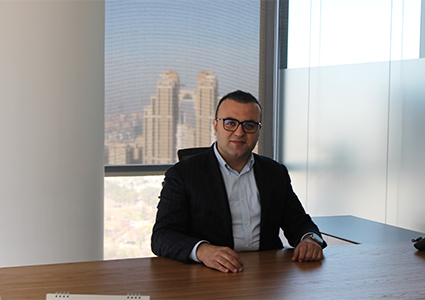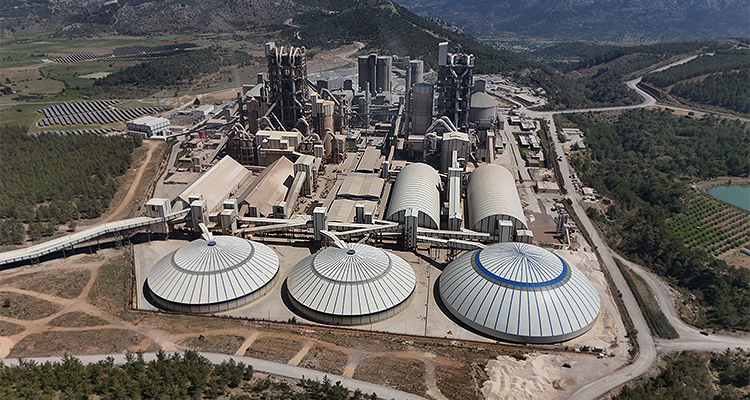Discover Medcem Cement Group’s approach to decarbonisation in the global cement industry
As a subsidiary of the Turkish company Eren Holding since 2015, Medcem Cement Group (Medcem) includes several divisions: Medcem Mining, Medcemport, Medcem Concrete, Medcem Cement, and Medcem Global. The Medcem Cement factory stands as one of the world’s largest cement plants, boasting an annual production capacity of 6.6 million tons of clinker. Approximately 85 percent of the facility’s output is exported to numerous countries through Medcemport. The export of Medcem’s products, such as cement, clinker, fly ash, synthetic gypsum, sub-base ash, bauxite, and iron slag, is managed by Medcem Global. Meanwhile, local sales of cement and concrete are handled by Medcem Concrete and Medcem Cement Sales and Marketing, thus closing the loop. Mehmet Ali Ceylan, the Chief Executive Officer of Medcem, provides insight into the operations and overall structure of its parent company, Eren Holding.

“Established in 1997, Eren Holding operates four main subsidiaries, with its energy business being the largest, accounting for eight per cent of Turkey’s electricity needs. Additionally, its paper and packaging divisions supply 40 per cent of the country’s requirements. As such, Eren Holding is by far Turkey’s largest player in these two industries. Furthermore, its textile and retailing company partners with Devanlay group that owns the Lacoste brand, producing 50 per cent of Lacoste branded items all over the world. These products are then distributed through a joint venture in over 20 countries. Eren Holding also manages several other brands, including Nautica, Gant, Burberry, and Superstep, among others. Notably, it manufactures products for Nautica and Gant, while also marketing various brands in Turkey and beyond. Lastly, Medcem, the cement branch of Eren Holding, is where I serve as CEO and board member,” he begins.
Growing global footprint
Shifting his focus back to Medcem, Mehmet sheds light on the company’s vast geographical footprint, which is vital for the production and export of its cement offerings. “In the southern part of Turkey, we operate a factory designed for exports that ranks among the biggest in the world within the cement industry. Indeed, with its production capacity, it is the largest factory in Europe, the US, and Africa. Close to the factory, we have our own port, through which we export nearly 85 per cent of our products. To enhance our market presence, we have started setting up terminals all over the world. Our first terminal opened in the UK, located in Sheerness, and is currently the largest cementitious terminal in Europe serving the London market. Moreover, we are investing in another terminal in Glasgow, set to be operational by the end of this year to serve Scotland. We also have a terminal under construction in Liverpool.
“In Europe, we have a functioning terminal in Northern Cyprus and are further expanding with terminals in Antwerp, Belgium, and Trieste, Italy, both of which will be operational within a few months. Meanwhile, in Africa, we have grinding facilities in Tunisia and Cameroon. Currently, we are making an investment in Florida, which will focus on grinding, with plans to commission it within a year. With these investments, our goal is to grow our global footprint significantly,” he enlightens.
Sustainable solutions
Along with the expansion of its international presence, Medcem is dedicated to diversifying its product portfolio while staying true to its roots in construction materials supply. “Cement and clinker are at the core of our offerings. We provide a wide variety of cement to our customers, and exporting to over 20 countries necessitates alignment with different customer requirements. The cement industry is currently under stringent environmental regulations that are getting stricter by the day. As a result, sustainability has become a key focus for us in our production processes. We are committed to producing lower-carbon embedded products for our customers by reducing the clinker content in our cement and increasing the use of alternative fuels. On top of that, we are making significant investments in renewable energy and utilising supplementary cementitious materials to replace clinker, thereby further helping us reduce the carbon footprint of our products.
 “Our ambitions extend beyond merely continuing our cement business. With a growing network of terminals around the world, we believe that we can create additional value by incorporating other construction materials into our portfolio. To that end, we are currently conducting market research in several countries to identify opportunities in other construction materials. Once we pinpoint viable options, we will invest in their production and leverage our shipping capabilities, whether through chartered vessels or our own fleet, to reduce transportation costs. This strategy will enable us to offer competitively priced construction materials. Ultimately, our goal is to become at least a mid-sized global provider of construction materials within the next five years,” Mehmet reveals.
“Our ambitions extend beyond merely continuing our cement business. With a growing network of terminals around the world, we believe that we can create additional value by incorporating other construction materials into our portfolio. To that end, we are currently conducting market research in several countries to identify opportunities in other construction materials. Once we pinpoint viable options, we will invest in their production and leverage our shipping capabilities, whether through chartered vessels or our own fleet, to reduce transportation costs. This strategy will enable us to offer competitively priced construction materials. Ultimately, our goal is to become at least a mid-sized global provider of construction materials within the next five years,” Mehmet reveals.
Forward-thinking leader
With environmental concerns becoming increasingly prominent in the construction sector, Mehmet discusses the complexities involved in decarbonising the cement industry in particular. “There are two primary approaches to reducing the carbon footprint of cement production. The first encompasses achievable methods within current processes, which include utilising supplementary cementitious materials to decrease clinker content, using more alternative fuels to replace fossil fuels, and implementing digital and artificial intelligence (AI) applications to enhance operational efficiency. These are all practical and achievable solutions given the present market landscape. The second approach involves new technologies that are currently unattainable, such as carbon capture and utilisation systems (CCUS). Such systems are inevitably needed by the industry to reach net-zero emissions, as it is impossible to eliminate all carbon dioxide from cement production solely through the achievable methods mentioned above.
“While there are other options, such as hydrogen-operated factories, these present their own challenges. For example, the electrolysis process to separate hydrogen from oxygen is currently very expensive and necessitates a significant amount of fresh water, which is a limited resource. Desalinating seawater for electrolysis is also very costly and burdensome. Another potential solution for reducing carbon dioxide emissions would be to electrify kilns and the entire production system. However, this requires a large renewable energy production source or significant energy storage capacity to manage and store the electricity generated. All in all, these solutions are particularly expensive and not supported by current market conditions. In regions like the UK and Europe, if mechanisms like the Carbon Border Adjustment Mechanism (CBAM) push for the adoption of such technologies, Medcem will certainly consider implementing them. But, as it stands, these technologies are not economically feasible yet,” he explains.
Moving forward, sustainability will be a fundamental component of Medcem’s long-term growth strategy. “I believe sustainability will remain the hottest topic in the industry, and we must focus on it to stay ahead of the competition. While sustainability is a core issue, macroeconomic conditions and politics are also essential for estimating potential consumption. Although there is currently excess capacity in the market, some regions are experiencing shortages. In this context, creative solutions and additional services offered by producers will be key to remaining strong in the market. Digitalisation and automation are also crucial, not only for the cement industry but across various sectors too, where they are already gaining traction,” Mehmet outlines.
Amidst growing environmental pressures, Medcem has emerged as a forward-thinking leader in the cement industry, poised to reshape the future of construction materials.
